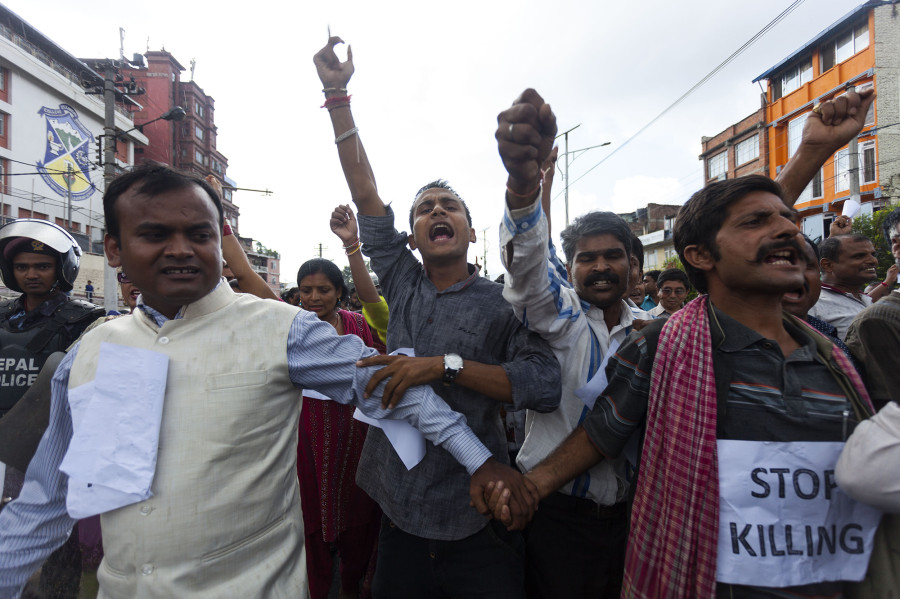National
Thirteen years on, Madhes movements, despite some momentum, remain incomplete
While representation, inclusion and federalism have materialised, their effectiveness and institutionalisation continue to be contested, analysts say.
Chandan Kumar Mandal
When a small group of Madhesi activists from a little-known socio-intellectual organisation burned copies of the interim constitution on January 16, 2007, few could have imagined that their actions would set the entire country down a path of deep structural change.
The spark ignited by the Madhesi Janadhikar Forum and its leader Upendra Yadav would spread across the Madhes. On January 19 that year, 17-year-old Ramesh Mahato was killed during the protests in Lahan. This was the first Madhes movement and it was followed by the second in 2008 and the third in 2015, with each iteration demanding that which Madhesis have long desired—equitable representation for the politics, culture and language of the Madhes. Mahato was later declared a martyr—the first martyr of the Madhes movement—and since January 19 is observed as its anniversary.
“If we retrospect about the Madhes movement, it was waged for identity, representation of Madhesi people in the country’s state apparatus and for autonomy,” said Rajkishor Rajak, a political commentator. “The Madhes movement brought the issues of state restructuring, identity, representation and federalism to the fore of national politics.”
But 13 years on, the Madhes movement remains incomplete, with their agendas for equality, proportional representation, an inclusive state and federalism yet to be fully realised.
“With the Madhes movement, the Madhesi people won but Madhesi leaders lost,” said Chandrakishore, a Madhes-based journalist.“They failed on two fronts. One, Madhesi leaders lacked negotiation skills and could not deal with the state while also demanding their rights. Second, they failed to generate inter-community dialogue and gain support from other groups.”
Despite the nation-wide influence of the movement, the returns were not as significant as expected, according to Chandrakishore.
In successive years, Madhes-based parties would rise to power and join several governments, securing lucrative ministries. Riding on the achievements of the Madhes movements, they made claims in the political arena, but were not committed to institutionalising those achievements, even for Madhesi communities. Their popularity slowly faded, and credibility was lost, even among their constituencies, say analysts.
“Leadership in Madhes politics turned out to be corrupt,” said Rajak. “Political leaders, who were once trained in various other political parties, turned out to be opportunists and traded the movement for their own political goals.”
For Tula Narayan Shah, a political analyst, it was the Constitution of 2015, promulgated when the Madhes was burning and Madhesi forces were not in a position to assert their claims, that diluted the achievements of the Madhes movements.
“But we cannot call the Madhes movements unsuccessful or say that it failed to achieve its major agendas,” said Shah. “The effects of the Madhes movements can be felt across all social and political levels. The movements challenged the established political order.”
But the socio-political agenda of the Madhes remained in the hands of a few upper-caste male leaders, with the issues of women, Dalits and Muslims marginalised once again. Benefits were milked by a handful of leaders, their family members and close aides, say analysts.
“Most people who lost their lives during the Madhes movements came from lower sections of the society, but those enjoying powerful positions are from higher castes and classes,” said Chandrakishore, a journalist who has followed Madhes politics for decades. “Their rights and representation are not seen in the Madhes as well. Calling these groups Madhesi is not enough. Restructuring is required inside the Madhes too.”
Untouchability, dowry and discrimination continue in many districts of the Madhes and even Province 2, the only province that is led by two Madhes-based parties which have 16 seats each in the federal Parliament, continues to fall behind on development indicators.
“Madhesi communities fought together, but have not evolved as a democratic society. It still is a caste-based society,” said Rajak. “The traditional power structure remains alive in Madhes and that is reflected in its politics as well. The upper castes are leading the political ideology whereas other marginalised communities are merely following suit.”
Federalism, one of the major demands of the movement, has finally been implemented but the Madhes’ demand for ‘One-Madhes, One Province’ has now been reduced to the eight districts of Province 2. The provincial government, the only one not led by the ruling Nepal Communist Party, is often at odds with the federal government.
“Constitutionally, we are a federal democratic state, but if we look at the content, it still looks like we are guided by a centralised mentality,” said Gyanendra Yadav, minister for internal affairs and law for Province 2. “Those against federalism are actively trying to ruin federalism, which is the achievement of the Madhes movement and needs to be protected at any cost.”
However, institutionalising all the achievements of the Madhes movements requires a larger strategy, said Yadav.
“We cannot always be guided by sentiment. We need a strategy to protect these achievements and regain what has been lost via constitutional amendments,” said Yadav. “This can either be done politically, for which we need support from others as well, or through the streets, which is the last resort.”
The two parties that are still demanding constitutional amendments are the Rastriya Janata Party Nepal and Samajbadi Party. Both supported the KP Sharma Oli administration after reaching a two-point deal on constitutional amendments, but the Janata Party withdrew support in March last year after its lawmaker Resham Chaudhary was handed a life sentence by a district court for masterminding Tikapur violence in August 2015. Samajbadi Party, born out of a merger between Upendra Yadav’s Sanghiya Samajbadi Forum and Baburam Bhattarai’s Naya Shakti, quit the government only recently, in December.
The two Madhesi parties have long been talking about building a united force to put pressure for constitutional amendments, but there has been no substantial progress. Earlier, the Janata Party had made Samajbadi Party’s withdrawal from the government a precondition for merger. But in a recent turn of events, Oli’s Nepal Communist Party seems to have cultivated its leaders—first by forging an electoral alliance for the National Assembly and now dangling the bait of deputy speaker.
As far as the Samajbadi Party is concerned, its sudden exit from the government has left it without any future plans.
Analysts say Madhesi parties easily fall for power and position and tend to forget the agenda they were carrying when they were protesting on the streets.
Federalism might be a force for good but even it has been co-opted by local elites and has become a pathway for corruption, says Chandrakishore.
“All the Madhes-based parties' aspire to become national political parties and have removed the ‘Madhes’ from their names,” he said. “This shows that they are not committed to the cause of the Madhes.”
The Madhes movements gave Madhes-based parties and their leaders the political capital to bargain with the state and other political forces, but personal interests and an ineffective leadership have not only caused the loss of credibility of Madhesi leaders among Madhesi society but have also sidelined them from the central stage of national politics.
“Madhes movements gave the Madhesi parties and their leaders authority and placed them at the forefront,” said Chandrakishore. “But there will be a drop in the coming decade and Madhesi forces will no longer be a decisive force in Nepali politics even though Madhesi issues remain alive.”




 16.4°C Kathmandu
16.4°C Kathmandu










%20(1).jpg&w=300&height=200)




